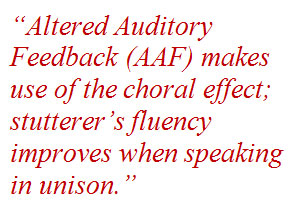Stuttering or stammering is a speech disorder that affects approximately 1% of the world population (Boyle, et al., 2011). Individual who stutters often face difficulties when speaking in highly stressful environments, such as communicating with superiors or teachers, delivering a speech, or making a phone call.
Traditional rehabilitation for stuttering involves speech therapy conducted by certified Speech-Language Therapists. Speech therapy commonly entails speech exercises to improve fluency and communication strategies to reduce stuttering symptoms. This method requires high commitment in terms of time and effort on the patient’s part before improvement can be seen.
AAF, DAF, FAF?
These past few years, anti-stuttering devices have emerged on the international market. These devices mostly use the Altered Auditory Feedback (AAF) technology. It makes use of the choral effect, where a stutterer’s fluency improves when speaking in unison. A device replays a user’s voice and either delays it by a few milliseconds (Delayed Auditory Feedback, DAF), or altering the pitch (Frequency Altered Feedback, FAF), to produce the same effect as when the user is speaking in unison with someone.

These electronic devices come in various forms and price range. Most are priced at thousands, and even exceed ten thousand ringgit, but lately applications and computer softwares which are more affordable are made available.
Devices that appear to look like hearing aids are widely used, for example the Speecheasy devices. These are preferred due to being smaller and more discreet, unlike AAF devices with earphones or headphones such as the SmallTalk . The following is a video of how the devices are worn: https://www.youtube.com/watch?v=o5ABpy_p9Ek
Speech Monitoring
Apart from portable AAF devices, computer technology that enables user to monitor and control their breathing rate and intonation is also useful in reducing stuttering. A microphone attached to the computer will collect the information on the user’s speech and feedback will be shown on the screen. Information provided include volume of speech, quality of voice, breathing patterns, and phonation strategies. The information aids in the practice of prolonged speech, a speech therapy technique to avoid stuttering incidents. The use of this technology, such as in Dr Fluency, is no longer widely used due to the existence of newer and portable applications or software for smartphones and tablets.
The few computer software that are still being used include:
These technologies enable the user to practice techniques learnt in therapy while applying the choral effect at the same time. However, the usage is restricted to in front of the computer.
Anti-Stuttering Mobile Apps
In line with the latest advancement in technology, DAF and FAF applications have been developed for smartphone and tablet users. Both major platforms Android and iOS offer applications such as Easy AAF, Smarty Ears, DAF Assistant, Stuttering Help, and Speech4Good.
Some applications enable the users to engage in phone conversations while using the DAF and FAF features. It makes it possible for a stutterer to overcome the common difficulties they face with phone conversations.
Other than DAF and FAF, there is also an application for stutterers to practice the Modifying Phonation Interval (MPI) technique. It trains a stutterer to prolong their speech rate at certain intervals only. This allows for a more natural speech to be produced. This application also allows DAF and FAF to be used concurrently with MPI, to ensure a more effective and lasting effect.
How Effective are Anti-Stuttering Technology?
Even though the use of anti-stuttering devices has been going on for over a decade, there have been very little studies on its effect. This is due to the variation of effects experienced by each individual user.
Some users reported satisfactory results, while others face problems including discomfort due to the noise or from wearing the device.
Some users feel that the DAF and FAF devices provide zero help in users with silent blocks in their stuttering as they were not producing any sound.
Most users claim the DAF and FAF devices only provide temporary effect as they do not reduce the psychological aspect of stuttering such as anxiety and worry.
In short, the use of anti-stuttering technology is not an easy solution for everyone. The variety in stuttering severity and characteristics as well as individual differences will decide the outcome. The best way is to choose a device after using it on a trial basis before committing to buying an expensive technology.
Most professionals also highly recommend the use of the devices together with speech therapy simultaneously. By attending speech therapy, stutterers can learn a few techniques to reduce stuttering which can give a long-lasting effect. They would also be able to gain communication or speech strategies to reduce the secondary stuttering characteristics such as anxiety or other psychological traits.
References
- AAF Apps and Software; peroleh Ogos 17, 2015 dari http://www.stammering.org/help-information/topics/therapy-treatment/electronic-devices-and-apps/aaf-apps-and-software
- Boyle C, Boulet S, Schieve L, Cohen R, Blumberg S, Yeargin-Allsopp M, Visser S, Kogan M. Trends in the Prevalence of Developmental Disabilities in US Children, 1997–2008. Pediatrics. 2011;34:385–395.
- Electronic Devices and Stuttering Treatment; peroleh Ogos 18, 2015 dari http://www.mnsu.edu/comdis/kuster/TherapyWWW/dafjanus.html
- Electronic Devices, Software, and Apps; peroleh Ogos 17, 2015 dari http://www.stutteringhelp.org/electronic-devices-software-and-apps
- Ward, David (2006). Stuttering and Cluttering: Frameworks for understanding treatment. Hove and New York: Psychology Press.
| Last Reviewed | : | 28 August 2020 |
| Writer / Translator | : | Siti Suhana bt. Mohd Khalid |
| Accreditor | : | Zaidi bin Ya’acob |
| Reviewer | : | Nadwah bt. Onwi |







